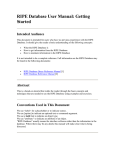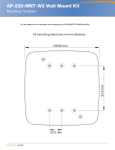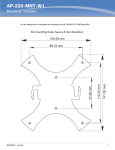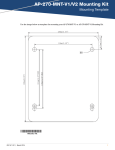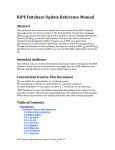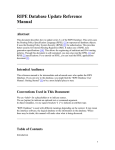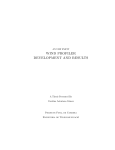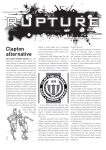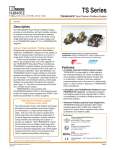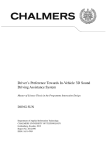Download RIPE Whois Database User Manual: Getting Started
Transcript
RIPE Whois Database User Manual: Getting Started Andrei Robachevsky Shane Kerr Vesna Manojlovic Vasco Asturiano Document ID: ripe-375 Date: May 2006 Obsolete: ripe-253 See also: ripe-358 Intended Audience This document is intended for users who have no previous experience with the RIPE Whois Database. It should give the reader a basic understanding of the following concepts: • What the RIPE Whois Database is • How to get information from the RIPE Whois Database • How to maintain information in the RIPE Whois Database It is not intended to be a complete reference. Full information on the RIPE Whois Database may be found in the following documents: • • RIPE Whois Database Query Reference Manual [1] RIPE Database Reference Manual [2] Abstract This is a hands-on tutorial that walks the reader through the basic concepts and techniques that are needed to use the RIPE Whois Database using examples and exercises. Conventions Used in This Document We use <label> for a placeholder or to indicate syntax. We use [option] to indicate an optional text or command argument. We use a BOLD font to indicate an object type. We use “attribute:” to indicate an attribute of an object. "RIPE Whois Database" usually means the interface software rather than the information in the database. Where there may be any doubt, this manual will make clear what is being discussed. Table of Contents RIPE Whois Database User Manual: Getting Started......................................................... 1 Intended Audience .......................................................................................................... 1 Abstract ........................................................................................................................... 1 Conventions Used in This Document ............................................................................. 2 Table of Contents............................................................................................................ 3 1.0 The RIPE Whois Database........................................................................................ 4 1.1 Database Objects................................................................................................... 4 1.2 TEST Database ..................................................................................................... 5 2.0 How to Get Information from the TEST Database................................................... 5 2.1 Web Queries.......................................................................................................... 5 2.2 Making Simple Queries ........................................................................................ 5 3.0 How to Maintain Information in the Whois Database .............................................. 6 3.1 Selecting the Database .......................................................................................... 6 3.2 Creating Objects.................................................................................................... 7 3.3 Registering Contact Information........................................................................... 8 3.4 Registering Authentication Information ............................................................. 11 3.5 Protecting Your Contact Information ................................................................. 15 3.6 Locating Network Assignments.......................................................................... 18 3.7 Recording Network Assignments ....................................................................... 21 3.8 Modifying the INETNUM Object ...................................................................... 25 3.9 Deleting Objects...................................................................................................... 27 4.0 Extra Features ......................................................................................................... 30 4.1 Keeping a Password in Webupdates Memory ................................................... 30 4.2 Edit an Object in Text-Based View Using Webupdates..................................... 30 4.3 Updates By E-mail.............................................................................................. 32 4.4 Whois Client ....................................................................................................... 34 4.5 Important Query Flags ........................................................................................ 35 5.0 Using the Production RIPE Whois Database.......................................................... 36 6.0 Where to Learn More.............................................................................................. 37 6.1 Whois Help ......................................................................................................... 37 6.2 Database FAQ..................................................................................................... 38 6.3 RIPE Whois Database Documents...................................................................... 38 6.4 LIR Training Courses ......................................................................................... 38 6.5 Specific Questions .............................................................................................. 38 References..................................................................................................................... 38 1.0 The RIPE Whois Database The RIPE Network Management Database, often called the ‘RIPE Database’ is a public database that contains information about registered IP address space and AS Numbers, routing policies, and reverse DNS delegations in the RIPE NCC service region. It is used for Internet network management. 1.1 Database Objects Records in the RIPE Database are called "objects". Each object is a list of "attributevalue" pairs displayed in plain text. An example: person: address: John Smith Example LTD High street 12 St.Mery Mead Essex, UK phone: +44 1737 892 004 e-mail: [email protected] nic-hdl: JS1-TEST remarks: ******************************* remarks: This object is only an example! remarks: ******************************* abuse-mailbox: [email protected] changed: [email protected] 20051104 source: TEST This is a person object for John Smith. The attributes are "person:", "address:", "phone:" and so on. An attribute name always starts in the first column, and ends with a colon (:). Everything after the colon is the value. Objects can store information about different resources. For example: Network Management Resource IP Address Ranges Routing Policies Reverse DNS Delegations Contact Information Authentication Information Object types inetnum, inet6num aut-num, route, route6 domain person, role, organisation mntner 1.2 TEST Database The RIPE NCC provides a TEST database where users can learn how to use the whois database software. The TEST database uses the same software as the RIPE Whois Database, but changes in one do not affect the other. The data in the TEST database is not a copy of the real data in the RIPE Whois Database and is provided purely for learning purposes. All examples below use the TEST database. However, all procedures described are the same for the RIPE Database. In section 5.0 Using the Production RIPE Whois Database, we will explain what the differences are when using the RIPE Whois Database. Do not use the production RIPE Whois Database for testing purposes. It is good practice to delete all objects you have created in the TEST database when you have finished the exercises in this guide. 2.0 How to Get Information from the TEST Database 2.1 Web Queries The simplest way to get information from the TEST database is to use the web interface available at: http://www.ripe.net/perl/test-whois 2.2 Making Simple Queries To query for a particular object the user specifies its "primary key:". This is an attribute value that identifies a unique occurrence of the object type. Object Type inetnum inet6num person Primary Key Attribute “inetnum:” “inet6num:” “nic-hdl:” Example Primary Key Value 193.0.0.0 - 193.0.0.255 2001:0610:0240::/42 JS1-TEST Example: We are going to query for the person object with the “nic-hdl:” attribute JS1-TEST. Type the following in the query box: js1-test The reply includes the object in section 1.1 Database Objects. Note that the attribute value is not case-sensitive. 3.0 How to Maintain Information in the Whois Database The RIPE Whois Database is used for storing information about Internet resources. You will need to create objects in the database to document your usage of these resources. Objects in the RIPE Whois Database must reflect the current state of the resources they describe. It is important to modify objects as the details of resources change, or delete objects if resources are no longer used. When IP addresses are assigned to customers, or new staff members are appointed as contacts, it is important to create new objects to reflect this in the database. You can make updates to the database by using the online update interface (webupdates) available at: https://www.ripe.net/fcgi-bin/webupdates.pl With webupdates, authorised users can directly create, modify or delete database objects using automated processing. After you submit an object update, the screen will return a complete report of the requested operation. If there were any errors, the update will fail, and the report will describe the reason(s) for this failure. If the error report does not help you locate the problem, you can send a copy of it to <[email protected]>. A RIPE NCC support engineer will help you locate the problem. The following sections describe the process of creating and maintaining objects in the TEST database. By the end of this document, you will have learned how to create and protect an object representing a network assignment. 3.1 Selecting the Database Throughout much of this document, you will learn how to perform modifications using the TEST database. Before each update is performed, you need to select the TEST database as source in webupdates. To select the TEST database as source, go to: https://www.ripe.net/fcgi-bin/webupdates.pl 1. Click [Select Source] in the header of webupdates: 2. Select “RIPE TEST database” from the list and press Select Update Source. 3.2 Creating Objects The inetnum object contains information about registered IP address space; this includes the range of addresses, status, and responsible contacts. Before this object can be created in the database, you must first create some preliminary objects. These objects contain information that is referenced by the inetnum object. This requires the creation of the following objects: • A person object that contains information about the administrative and technical contacts for this network. This is referenced from the "admin-c:" and "tech-c:" attributes of the inetnum object. • A mntner object that contains authentication information that identifies who can modify the contents of this object. This is referenced from the "mnt-by:" attribute of the inetnum object. The mntner object protects the inetnum object. 3.3 Registering Contact Information Contact information, such as a phone number and e-mail address, is stored in the person object. To create a new person object in the database: 1. Select the TEST database as your update source. We tell you how to do this in section 3.1 Selecting the Database. 2. Click on the [Add] option (in the header of webupdates) to create a new object in the TEST Database and select object type: “person”: 3. Click on Add Object. 4. In the next screen, enter the information for the attributes of the object that you are creating. An attribute has two main characteristics: • Mandatory/Optional – If an attribute is mandatory, it must always be present in any object of that type that is stored in the RIPE Whois Database. If it is optional, you can leave it out. • Single/Multiple – If an attribute is single, then only one attribute of that type can be present in an object. If it is multiple, the object can contain more than one instance of the same attribute. Note: To see the full template of an object type including the characteristics of all its attributes, you can query the database for: “-t [object type]”. Example: Click on [Query Database] and enter: -t person person: address: phone: fax-no: [mandatory] [mandatory] [mandatory] [optional] [single] [multiple] [multiple] [multiple] [lookup key] [ ] [ ] [ ] e-mail: org: nic-hdl: remarks: notify: abuse-mailbox: mnt-by: changed: source: [optional] [optional] [mandatory] [optional] [optional] [optional] [optional] [mandatory] [mandatory] [multiple] [multiple] [single] [multiple] [multiple] [multiple] [multiple] [multiple] [single] [lookup key] [inverse key] [primary/look-up key] [ ] [inverse key] [inverse key] [inverse key] [ ] [ ] When creating a new object with webupdates, only the mandatory attributes are shown automatically. You can add optional attributes and/or other instances of multiple attributes by using the Add New Field section. Return to the webupdates screen and prepare a person object to be created in the TEST database. Use "AUTO-1" for the "nic-hdl:" attribute, your e-mail address for the "changed:" attribute, and "TEST" for the "source:" attribute. By checking the Force New box, you guarantee that the object is only created if it does not already exist in the database. We recommend that you keep this option checked, to avoid accidentally modifying an existing object. 5. When you have finished setting up the object, press Submit Update. 6. Wait for an acknowledgement from the TEST database to appear on your screen. This may take some time to complete. Here is an example of the type of message you will see, if your update is successful: Create SUCCEEDED: [person] JS1-TEST John Smith ***Warning: Date '20051104' added to changed: attribute '[email protected]' Note: The text after the [person] tag (JSI-TEST) is the NIC handle of the person. It replaces the AUTO-1 value of the “nic-hdl:” attribute in the original submission. It will be unique and is the primary key of this person object. Any references to this person object will use this NIC handle. You can use the new NIC handle value to query for this object. If you do this, you can also see that the "changed:" attribute has had the date of the creation added. This is normal behaviour and is the reason for the “***Warning:” message in the example above. If there was an error, the acknowledgement will tell you that the update has failed and will also report any errors. For example, it may contain the following: Update FAILED: [person] AUTO-1 John Smith ***Error: Syntax error in object This message means that the update failed because of a problem with the syntax in the object. Check for invalid attribute values to find the cause of the error. 3.4 Registering Authentication Information "Authentication" is when you prove that you are who you claim to be. This information is prevents other users from modifying your data. In the database, the information that verifies authentication is stored in the mntner object (also called the maintainer object). To create a new mntner object in the database, do the following: 1. As with the creation of your person object, choose the TEST database as update source, and then select mntner from the object list in the [Add] section: 2. Set up your mntner object using webupdates. Follow the same steps that you used previously for the person object. Note: For any object type, you can get the object’s template with a detailed description of the meaning and syntax of each allowed attribute, by querying for: “-v [object type]”. To get a full description of all the mntner object’s fields, query the RIPE Whois Database for: -v mntner Check the syntax definition for the “mntner:” attribute field, when choosing your own mntner name: A unique identifier of the mntner object. Made up of letters, digits, the character underscore "_", and the character hyphen "-"; the first character of a name must be a letter, and the last character of a name must be a letter or a digit. For the "admin-c:" and "tech-c:" attributes, you should use the value of the "nic-hdl:" from the person object that you created earlier in this tutorial. The database will not allow you to create a mntner object unless this person object already exists. The "auth:" attribute begins with a keyword identifying the authentication method. This is followed by the authentication information. In the example below, we have used the MD5-PW method. For both the MD5-PW and CRYPT-PW methods, a password is used to authenticate database updates. To encrypt your password to either MD5-PW or CRYPT-PW, you can use this web tool: https://www.ripe.net/cgi-bin/crypt.cgi Here is an example of an “auth:” attribute using an MD5 encrypted password: auth: MD5-PW $1$9KZv4vZf$zD8GoM7Ppvc74ypGmjedt/ The “mnt-by:” attribute refers to the mntner that is authorised to perform updates on an object. The mntner object usually maintains itself, so use your maintainer name (the value of the “mntner:” attribute) in the “mnt-by:” attribute. Use "TEST-DBM-MNT" in the "referral-by:" attribute. 3. When you have finished composing the object, press Submit Update. 4. Wait for an acknowledgement from the TEST database to appear on your screen. This may take some time to complete. Here is a sample of the type of message you will see, if your update is successful: Create SUCCEEDED: [mntner] EXAMPLE-MNT If there was an error, correct the faulty attribute value(s) and re-submit the update. 5. The e-mail address in the “mnt-nfy:” attribute of the mntner will receive an email that will contain details of the new object. You can now query the whois server and see your new mntner object. Type the following in the query window, substituting your mntner name: -B example-mnt Your new mntner object, as well as the person object referenced, will be returned. % Information related to 'EXAMPLE-MNT' mntner: descr: admin-c: tech-c: EXAMPLE-MNT Sample maintainer for example JS1-TEST JS1-TEST upd-to: mnt-nfy: auth: notify: abuse-mailbox: mnt-by: referral-by: changed: source: [email protected] [email protected] MD5-PW $1$wCDUXtMe$MptgAFcPa3sy9QqQnbX4X/ [email protected] [email protected] EXAMPLE-MNT TEST-DBM-MNT [email protected] 20051104 TEST person: address: John Smith Example LTD High street 12 St.Mery Mead Essex, UK +44 1737 892 004 [email protected] JS1-TEST ******************************* This object is only an example! ******************************* [email protected] [email protected] 20051104 TEST phone: e-mail: nic-hdl: remarks: remarks: remarks: abuse-mailbox: changed: source: Note: the “-B” flag in the query is used in order to retrieve the complete objects from the whois database. In a default query (without the “-B” flag), user contact information is filtered from the returned data. This helps to protect users from contact abuse. Filtered query results are easy to identify by looking at the “source:” attribute: source: TEST # Filtered If the keyword “# Filtered” is shown, it means that the query result has been filtered and some of the attributes are not shown. By default, a query returns other objects containing associated contact information. This is why it returns the person object. If you do not want to see this information, use the ‘-r’ (disable recursion) flag in your query. You can see how this works by typing the same query with this flag: -r -B example-mnt This time, only the mntner object is returned. Disabling recursion can result in a smaller, easier to understand reply, especially when associated contact information is unimportant. This is often the case when managing your own objects. 3.5 Protecting Your Contact Information Now that you have a mntner object, you can protect other objects in the database. An object is protected by putting in a reference to the mntner in the "mnt-by:" attribute. Most object types require you to protect them with your mntner object. However, person objects do not. We recommend that you protect them. To protect your person object: 1. As before, within webupdates, choose the TEST database as your update source, click on the [Edit] option and enter your person object “nic-hdl:” You can also enter your “person:” name instead of the “nic-hdl:” value. In this case, a list will be returned with all person objects that have that name. For common names, there may be many entries returned. Choose your object from this list. 2. The editor screen that follows, will show your person object with all of its current attribute values: Using the Add New Field section, add your mntner as the "mnt-by:" for your person object. Fill in the value of the new attribute with your mntner object: The database will not allow you to use a "mnt-by:" value, unless the mntner object already exists. An error will appear in the acknowledgement returned after you submit the update. 3. Add an additional “changed:” attribute to reflect the fact that you are modifying the object. Follow the same procedure shown above for the “mnt-by:” attribute. It must be placed after the existing “changed:” attribute values. 4. When you add a “mnt-by:” attribute to an object, you must authenticate yourself as the new mntner object. As this example uses the MD5-PW method, add a “password:” field to the object, using the Add New Field section. The position of this field in the object is not important. In this new “password:” field, type the clear-text password that you used to encrypt the MD5 string present in the “auth:” attribute of your mntner object. For example: 5. The final edited object should look similar to the one shown below. Click on Submit Update when you are ready. 6. Wait for an acknowledgement from the database. This will indicate the success or failure of your update. If the password entered did not match the one used in the mntner object, the update will fail and you will see a message similar to: Modify FAILED: [person] JS1-TEST John Smith ***Error: Authorisation failed ***Info: Syntax check passed In this case, you can just correct the password and re-submit the update. 3.6 Locating Network Assignments Network assignments are represented by inetnum objects. Before you can create a new inetnum object, you must find a range of IP addresses that are not currently assigned. This section describes how you can query the database for this information. You can also use the queries whenever you want to get IP address information from the database. By default, the database returns the smallest range that encompasses the entire range that you specify in your query. This is a ‘less specific’ object. For example, if you query the following: 10.11.12.0 - 10.11.13.255 You might get something like this: inetnum: netname: descr: descr: details country: admin-c: tech-c: status: remarks: enterprise remarks: mnt-by: mnt-lower: mnt-routes: source: 10.0.0.0 - 10.255.255.255 IANA-ABLK-RESERVED1 Class A address space for private internets See http://www.ripe.net/db/rfc1918.html for EU # Country is really world wide AA1-TEST AA2-TEST ALLOCATED UNSPECIFIED This network should never be routed outside an See RFC1918 for further information TEST-DBM-MNT TEST-DBM-MNT TEST-DBM-MNT TEST # Filtered This is called the less specific match. The range 10.11.12.0 - 10.11.13.255 fits entirely within the range 10.0.0.0 - 10.255.255.255. This is the smallest inetnum object in the database that encompasses the IP range in your query. If you want the server to give you only an exact match, then you can request this using the "-x" flag. An exact match is one where the IP range of the inetnum object is the same as the IP range in the query. -x 10.11.12.0 - 10.11.13.255 In this case you will get only an exact match, or an error that tells you that no such inetnum object exists: %ERROR:101: no entries found % % No entries found in the selected source(s). Sometimes, you may want to see all of the less specific inetnum objects that encompass a range. In this case, you can use the "-L" flag. If you do this, you will see all inetnum objects that encompass the entire range queried, as well as any exact match. For example, if you query the following: -L 10.11.12.0 - 10.11.13.255 You might get something like this: % Information related to '0.0.0.0 - 255.255.255.255' inetnum: netname: descr: country: org: admin-c: tech-c: status: remarks: mnt-by: mnt-lower: mnt-routes: remarks: source: 0.0.0.0 - 255.255.255.255 IANA-BLK The whole IPv4 address space EU # Country is really world wide ORG-TT1-TEST AA1-TEST AA2-TEST ALLOCATED UNSPECIFIED The country is really worldwide. TEST-ROOT-MNT TEST-DBM-MNT TEST-DBM-MNT This is an automatically created object. TEST # Filtered % Information related to '10.0.0.0 - 10.255.255.255' inetnum: netname: descr: descr: details country: admin-c: tech-c: status: remarks: enterprise remarks: mnt-by: mnt-lower: mnt-routes: source: 10.0.0.0 - 10.255.255.255 IANA-ABLK-RESERVED1 Class A address space for private internets See http://www.ripe.net/db/rfc1918.html for EU # Country is really world wide AA1-TEST AA2-TEST ALLOCATED UNSPECIFIED This network should never be routed outside an See RFC1918 for further information TEST-DBM-MNT TEST-DBM-MNT TEST-DBM-MNT TEST # Filtered For the query examples shown above, the “-B” flag was not included. The output from the whois database was filtered for contacts, as described in 3.4 Registering Authentication Information. Therefore, the objects above are not shown fully. The “# Filtered” tag in the “source:” attribute tells you that the object was filtered. From here on, we will use the “-B” flag in most queries. This will retrieve the full objects as they are stored in the database itself. You can also look for smaller inetnum objects corresponding to sub-ranges that are completely contained within a given range. This is a more specific query. You can use this on an allocation to look for ranges that have no other assignments. To do this, use the "-m" flag. -B -m 10.11.0.0 - 10.11.255.255 You will get a reply that looks something like this: % Information related to '10.11.11.0 - 10.11.11.255' inetnum: netname: descr: descr: country: admin-c: tech-c: status: notify: mnt-by: mnt-lower: mnt-routes: changed: source: 10.11.11.0 - 10.11.11.255 Example-Network This is a fictitious assignment for the End-User called "Example" GB JS1-TEST JS1-TEST ASSIGNED PA [email protected] EXAMPLE-MNT EXAMPLE-MNT EXAMPLE-MNT [email protected] 20051125 TEST % Information related to '10.11.13.0 - 10.11.13.255' inetnum: netname: descr: descr: country: admin-c: tech-c: status: notify: mnt-by: mnt-lower: mnt-routes: changed: source: 10.11.13.0 - 10.11.13.255 Example-Network-2 This is another fictitious assignment for the End-User called "Example" GB JS1-TEST JS1-TEST ASSIGNED PA [email protected] EXAMPLE-MNT EXAMPLE-MNT EXAMPLE-MNT [email protected] 20051125 TEST This is a one-level more specific query. This means that the largest inetnum object that is completely contained within the given range is returned. In this example, the IP addresses 10.11.12.0 - 10.11.12.255 are not assigned and are available. You will need to find an available range to do the exercise in the next section. If you want to see all inetnum objects completely contained in a given range, you can use the "-M" flag: -M 10.0.0.0 - 10.255.255.255 This will return all levels of inetnum objects in the range. This can return an extremely large number of objects, but can be useful for finding all of the inetnum objects for a portion of the Internet. 3.7 Recording Network Assignments Now that all of the objects necessary for an inetnum object have been created and protected and you have located an appropriate range of IP numbers, you can create the inetnum object itself. To create a new inetnum object in the database: 1. As before, choose the TEST database as source, then click on [Add] to create a new inetnum object: 2. Use the object editor to enter your network information. The following attributes are worth mentioning: • For the “inetnum:” attribute, enter the IP range that you want to register. Since this is just for the TEST database, it doesn’t have to be a range that is really allocated to your organisation. You can use any available IP range. Follow the instructions in section 3.6 Locating Network Assignments to find an available IP range in the TEST database. • For the “admin-c:” and “tech-c:” attributes, use the nic-hdl of your person object. • For the “status:” attribute use ‘ASSIGNED PA’. • For the “notify:” attribute, use the e-mail address where you wish to be notified of any updates to this object. • For the “mnt-by:” or any other “mnt-*:” attribute, use the name of your maintainer. You can get a full explanation of the syntax and meaning of all the attributes in this object by querying for: -v inetnum This will work for any object type. Once again, you will need to provide authentication for your maintainer to create this object. Add your maintainer password to the field “password:”. You can find out how to do this in Section 3.5 Protecting Your Contact Information. The creation of new inetnum objects must also be authorised hierarchically. This means that while creating an inetnum object, the authentication for the one-level less specific inetnum object (encompassing IP address range) is also required. The “mnt-lower:” attribute in inetnum objects allows you to specify a specific maintainer for the creation of more specific (sub-assignments) inetnum objects. To find out for which specific maintainer you must provide authentication, do the following: • Query the whois database for the one-level less specific inetnum object: -l [your IP range] • Look for the mntner object referenced in the “mnt-lower:” attribute. If there is no “mnt-lower:” attribute, the mntner object referenced in the “mnt-by:” attribute is used. For this specific example, querying for the one-level less specific object (-l 10.11.12.0 10.11.12.255) shows that it has: mnt-lower: TEST-DBM-MNT To allow users to freely create inetnum objects in the TEST database, we have published the password for this maintainer. You can find it in the mntner object itself: mntner: descr: admin-c: tech-c: auth: remarks: remarks: remarks: mnt-by: referral-by: remarks: source: TEST-DBM-MNT Mntner for TEST DBM objects. AA1-TEST AA2-TEST MD5-PW $1$N2zhyJ3g$hzX7XTL84DtBkCWhBZE2c/ **************************************************** Password is "emptypassword" without the quotes. **************************************************** TEST-ROOT-MNT TEST-ROOT-MNT This is an automatically created object. TEST # Filtered To pass the hierarchical authentication, you need to add an extra “password:” field to the object update with the password from TEST-DBM-MNT: 3. See below for an example of a new inetnum object. Click on Submit Update. 4. Wait for the acknowledgement to return from the whois database. If your update was successful, you will get a reply containing something like the following: Create SUCCEEDED: [inetnum] 10.11.12.0 - 10.11.12.255 If there was an error, the acknowledgement will tell you what errors were found. For example, it may contain the following: Update FAILED: [inetnum] 10.11.12.0 - 10.11.12.255 ***Error: Syntax error in object 5. If it is successful, the e-mail address in the "mnt-nfy:" attribute of your mntner object will receive an e-mail with the details of the new object. 3.8 Modifying the INETNUM Object You can modify information in your inetnum object. You might need to do this if the technical contact has changed and is now represented by the person object "MJ3-TEST". (You must first create a new person object before you can follow this example.) To modify an existing object, do the following: 1. Click on [Edit] in webupdates. In the text box, enter one IP address of the inetnum object range, the full IP range, the “netname:”, or even the name from the referenced person object(s). Click on Edit Object. 2. From the “Search Results” list, select your inetnum object and click on Edit. 3. Using the object editor, change the "tech-c:" attribute to the new person object. Add a "notify:" attribute, so the new technical contact will be notified when the inetnum object is modified. You also need to include the password for your maintainer so that the modification is authorised, as well as a new “changed:” line to keep track of the history of modifications to the object. The new “changed:” line must follow all existing ones. Note: The hierarchical authorisation is only required for creation of inetnum objects, not modification. You do not have to include the second password (from the less-specific IP block) in this update. You cannot change the primary attribute of the object (inetnum: 10.11.12.0 10.11.12.255). The database will consider this to be a creation of a new object. 4. Click on Submit Update to process this: 5. Wait for an acknowledgement from the database. This will tell you if your update was successful. If there was an error, the message that you receive will tell you what was wrong. 6. The e-mail address in the "notify:" attribute of the original object will be sent a message with the details of the change. In a similar way, a notification e-mail will be sent to the “mnt-nfy:” of the maintainer. 3.9 Deleting Objects Sometimes you no longer need objects that you maintain. You should delete these. For example, if an assignment is no longer used you should delete the inetnum object and all person and mntner objects that are only referenced from that object. To delete an existing object: 1. Select the object that you wish to remove using the [Edit] option in webupdates. Follow steps 1 and 2 in Section 3.8 Modifying the INETNUM Object. 2. In the object editor, do not change any of the attributes. If the object submitted is not an exact copy of the one stored in the whois database, the deletion will fail. Add only a “password:” field to authenticate you as the valid maintainer. Deletion of objects in the RIPE/TEST database must also be authorised. 3. At the bottom of the editor page, enter the reason for this object deletion in the Reason box. Click on Delete Object, when done. This will automatically submit the update for processing to the TEST database adding a line in the format: delete: [reason for deletion] This indicates that this object is to be deleted from the database. Example of a deletion: 4. Press Submit Update. 5. Wait for an acknowledgement from the database. This will tell you if your deletion was successful. 6. The e-mail addresses in the "notify:" attribute of the object, as well as the “mntnfy:” attribute of the mnt-by: mntner, will receive a message with the details of the deletion. Objects that are referenced by other objects cannot be deleted. For example, a mntner object cannot be deleted while it is used in "mnt-by:" or any other attribute. You can find the references to a mntner object by using an inverse query. Type the following in the query window, substituting your mntner object: -i mnt-by,mnt-lower,mnt-routes,mnt-domains,mnt-ref -r EXAMPLE-MNT This will return all of the objects that reference EXAMPLE-MNT. The "-i" flag requests the inverse query, and the "mnt-by,mnt-lower,mnt-routes,mnt-domains,mnt-ref" specify which attributes you want to look at. There must not be a space after any of the commas. The "-r" disables recursion (associated objects will not be displayed). Before you can delete a mntner object, you must remove all references to it. For example, if you have the following mntner and person objects: % Information related to 'EXAMPLE-MNT' mntner: descr: admin-c: tech-c: upd-to: mnt-nfy: auth: notify: abuse-mailbox: mnt-by: referral-by: changed: source: EXAMPLE-MNT Sample maintainer for example JS1-TEST JS1-TEST [email protected] [email protected] MD5-PW $1$wCDUXtMe$MptgAFcPa3sy9QqQnbX4X/ [email protected] [email protected] EXAMPLE-MNT TEST-DBM-MNT [email protected] 20051104 TEST % Information related to 'JS1-TEST' person: address: phone: e-mail: nic-hdl: mnt-by: remarks: remarks: remarks: abuse-mailbox: changed: changed: source: John Smith Example LTD High street 12 St.Mery Mead Essex, UK +44 1737 892 004 [email protected] JS1-TEST EXAMPLE-MNT ******************************* This object is only an example! ******************************* [email protected] [email protected] 20051104 [email protected] 20051109 TEST The mntner "EXAMPLE-MNT" cannot be deleted, because it is referenced by the person "JS1-TEST". The person "JS1-TEST" cannot be deleted, because it is referenced by the mntner "EXAMPLE-MNT". To delete these objects, do the following: 1. Modify the person object, and remove the "mnt-by:" attribute. This removes all protection, but this is not a security issue, because the object will be deleted. 2. Delete the mntner object. 3. Delete the person object. (Please remember to delete all objects you created in the TEST database while doing these exercises.) 4.0 Extra Features 4.1 Keeping a Password in Webupdates Memory If you want to use your maintainer authentication password in several updates, you can keep it in memory for a specified amount of time. To do this: 1. Before starting to update any of your objects, click on the [Authorisation] option. 2. Type in your password and select the amount of time that you want to keep your password in memory. 3. Click on Register You can now start editing your objects. From here on, and for however long that you specify, all updates submitted through webupdates from your computer will automatically include the password you entered. 4.2 Edit an Object in Text-Based View Using Webupdates Using webupdates, you can edit an object in text-based mode, as opposite to the fieldbased interface used so far. This can be helpful in situations when copy-paste operations are needed. This is done using the Switch View option. It allows you to switch between ‘field-based’ and ‘text-based’ editing. For example, if you are editing an object as shown below: Pressing the Switch View button allows you to switch to text-based mode: In this mode, you can edit the object as free text, including adding and removing attributes to the object. Pressing Switch View once again switches back to the field-based interface. Pressing Submit Update submits your update to the whois database. You can switch between both edit modes interchangeably while editing an object. However, please notice that webupdates will only let you switch from text-based mode to field-based mode, if there are no syntax errors in the object. 4.3 Updates By E-mail Another way of updating objects in the RIPE/TEST database is by using e-mail. This is useful if you need to update several objects at the same time. You should send updates to the TEST database to <[email protected]>. We automatically process all updates sent to this e-mail address, no human handling is involved. Follow these steps when you prepare your e-mail: 1. Include the complete objects that you wish to update (create, modify or delete) in the e-mail, with at least one blank line between each object, and completely aligned to the left (no space characters in the beginning of the lines). Please don’t include any blank lines in between the attributes of any object, as this will prevent it from being recognised. 2. If you want to delete an object, include the complete object exactly as stored in the whois database and add an extra field to the object with the syntax: delete: [reason for deleting] 3. Include in the e-mail, all the clear-text passwords needed to perform the updates, with the following syntax: password: [clear-text password] 4. Send your e-mail to <[email protected]> Here is an example of an e-mail update to the TEST database: inetnum: netname: descr: 10.11.12.0 - 10.11.12.255 Example-Network This is a new fictitious assignment for the end-user called "Example" country: NL admin-c: JS1-TEST tech-c: MJ3-TEST status: ASSIGNED PA notify: [email protected] notify: [email protected] mnt-by: EXAMPLE-MNT mnt-lower: EXAMPLE-MNT mnt-routes: EXAMPLE-MNT changed: [email protected] 20051129 changed: [email protected] 20051130 source: TEST delete: IP assignment has been cancelled person: address: phone: e-mail: nic-hdl: mnt-by: remarks: remarks: remarks: abuse-mailbox: changed: changed: changed: source: John Smith Example LTD High street 12 St.Mery Mead Essex, UK +44 1742 812 991 [email protected] JS1-TEST EXAMPLE-MNT *********************************************************** This object is still an example, but the phone has changed! *********************************************************** [email protected] [email protected] 20051104 [email protected] 20051109 [email protected] TEST password: this is my clear-text password, really! After your update has been processed, you will receive the results by e-mail. The reply will tell you which objects were updated successfully and which ones failed. For the objects that failed, you will get an explanation with the errors. This is similar to what is shown in the webupdates report. 4.4 Whois Client You can also perform queries on the database by using a whois software client. There is a whois client, developed by the RIPE NCC, available for free download. [3] To perform queries on the TEST database, use the syntax: whois –h test-whois.ripe.net <query-text> Where <query-text> is the full query text that would be entered in the web query box shown in Section 2.1 Web Queries. 4.5 Important Query Flags Here is a list of commonly used flags that can be useful when querying the whois database. Please note that these flags are case-sensitive. General query flags: -B Disables the default query behaviour of filtering the "notify:", "changed:" and "email:" attributes, in place to protect users from contact abuse. This flag is helpful for retrieving the objects exactly as they are stored in the whois database. It is important to use this flag when updating database objects by e-mail, to prevent information from being lost in the update. -r Disables the default query behaviour of recursion for contact information after retrieving the objects that match the lookup key. You should use this flag if you do not want to retrieve also the person and role objects that contain the contact information associated to the object that you are querying for. -t <object-type> Requests a template for the specified object type. Using this flag you can see all the possible attributes used in an object type as well as their characteristics. -v <object-type> Requests a verbose template for the specified object type. This flag works as –t, but also gives you a detailed explanation of each attribute, and the expected syntax. It can be very helpful when you receive a syntax error while updating an object in the whois database. -i <attribute-name> <inverse-key> Perform an inverse query. This flag is useful to see in which objects a certain object is referenced. For example: -i mnt-by EXAMPLE-MNT will show all the objects that are maintained for updates by the maintainer EXAMPLE-MNT. IP range query flags: -l <ip-lookup> One-level less specific query. This returns the smallest inetnum range that encompasses the entire IP range specified in the query, excluding the exact match. -L <ip-lookup> All-levels less specific query. This returns all the less specific inetnum objects that encompass the IP range specified in the query, including the exact match. -m <ip-lookup> One-level more specific query. This returns the largest inetnum ranges that are completely contained in the IP range specified in the query, excluding the exact match. -M <ip-lookup> All-levels more specific query. This returns all the levels of inetnum objects contained in the IP range specified in the query, excluding the exact match. This can return an extremely large number of objects, depending on which IP range is used. -x <ip-lookup> Exact match query. This returns the inetnum object that exactly corresponds to the IP range specified in the query. If no exact match is found no objects are returned. In a default IP range query, without any of the flags mentioned above, the exact match object will be returned. If no exact match is found, the one-level less specific inetnum object will be returned. To see a full list of all the flags that you can use when querying the whois database, enter ‘help’ in the query box: help 5.0 Using the Production RIPE Whois Database You should now have an understanding of the basic concepts of the RIPE Whois Database and be able to maintain your own data and perform queries. This section explains the differences between the TEST database and the RIPE Database. For the RIPE Whois Database: 1. Queries use a different search tool: http://www.ripe.net/whois 2. For queries using a whois client, connect to the server: whois.ripe.net whois –h whois.ripe.net <query-text> 3. In webupdates, select RIPE Database as the source (default), by using the [Select Source] option: 4. You should send e-mail updates to the RIPE Database to <[email protected]>. 5. Objects in the RIPE Database use RIPE for both the “source:” attribute and the suffix appended to “nic-hdl:” attributes. 6. When creating your mntner object in the RIPE Whois Database, use RIPE-DBMMNT for the “referral-by:” attribute. 7. You cannot create inetnum objects in the RIPE Whois Database unless you have received authorisation from the LIR that holds the responsibility for that address range. 6.0 Where to Learn More The following resources are available to help you use the RIPE Whois Database. 6.1 Whois Help A query for "help" will return a full list of all of the ‘flags’ that you can use when you query the database. help While we covered some of these in this document, there are many others. To receive detailed information about an object type and all of its attributes, query for: -v <object-type> 6.2 Database FAQ The Database Frequently Asked Questions (FAQs) are available at: http://www.ripe.net/info/faq/db/index.html We frequently update this page with helpful information based on the needs of users and new features offered by the software. 6.3 RIPE Whois Database Documents The definitive source of information for the RIPE Whois Database is the database area of the RIPE Document Store: http://www.ripe.net/ripe/docs/database.html Here you can find the latest versions of the RIPE Whois Database Reference Manuals, which contain detailed information about all of the topics covered in this guide, as well as other relevant documents covering how to use the RIPE Whois Database. 6.4 LIR Training Courses The RIPE NCC provides training for Local Internet Registries. You can find more information about this at: http://www.ripe.net/training/ 6.5 Specific Questions If you have a specific question that has not been answered in this guide, send it to <[email protected]>. A RIPE NCC support engineer will answer your mail. You can also post a question to the <[email protected]> mailing list. You can find information about this list at: http://www.ripe.net/mailman/listinfo/db-help/index.html References [1] RIPE Whois Database Query Reference Manual: http://www.ripe.net/ripe/docs/db-query-manual.html [2] RIPE Database Reference Manual http://www.ripe.net/ripe/docs/databaseref-manual.html This contains detailed information about updating objects in the RIPE Whois Database. It will be replaced by a new document: “RIPE Whois Database Update Reference Manual”. [3] Whois Client You can find the latest version at: http://whois.sourceforge.net/







































